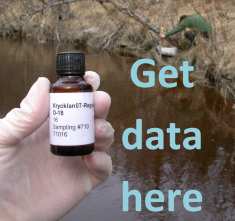Contact
Department of Forest Ecology and Management, Department of Forest Ecology and Management, joint staff
Unit for Field-based Forest Research
Krycklan is an integral part of the Svartberget field research infrastructure, which belongs to the Swedish University of Agricultural Sciences (SLU). The Krycklan catchment encompasses the natural mosaic of boreal landscapes consisting of forests, mires, streams and lakes that make up 70% of the area in Sweden, and which is representative of 30% of the world’s forest cover.
Krycklan provides the most advanced and accessible long-term field research infrastructures in operation in the boreal biome. The ongoing field activities include over 50 research projects, involving several hundred scientists from all major universities in Sweden and 30 countries. In total ~ 40 PhD students conduct research at the site. Since its beginning in 1910, over 1000 scientific publications have contained results from Svartberget, including several in Nature and Science. In addition, 98 PhD-theses, the first published 1923, have been based on results from the site. Approximately half of this is from the Krycklan catchment.
Download the Krycklan field guide here
As Svartberget is a part of SITES, krycklan is also included in this VR initative
All 19 intensively sampled streams are monitored according to hydrology. To develop accuracy of the hydrological calculations V-noch wires and flumes are installed in a majority of the streams. All steams are equipped with pressure transducers which hourly calculate averages of air and water temperature along with water stage height. Additional salt dilution and bucket measurements are performed to validate the calibrations monthly.
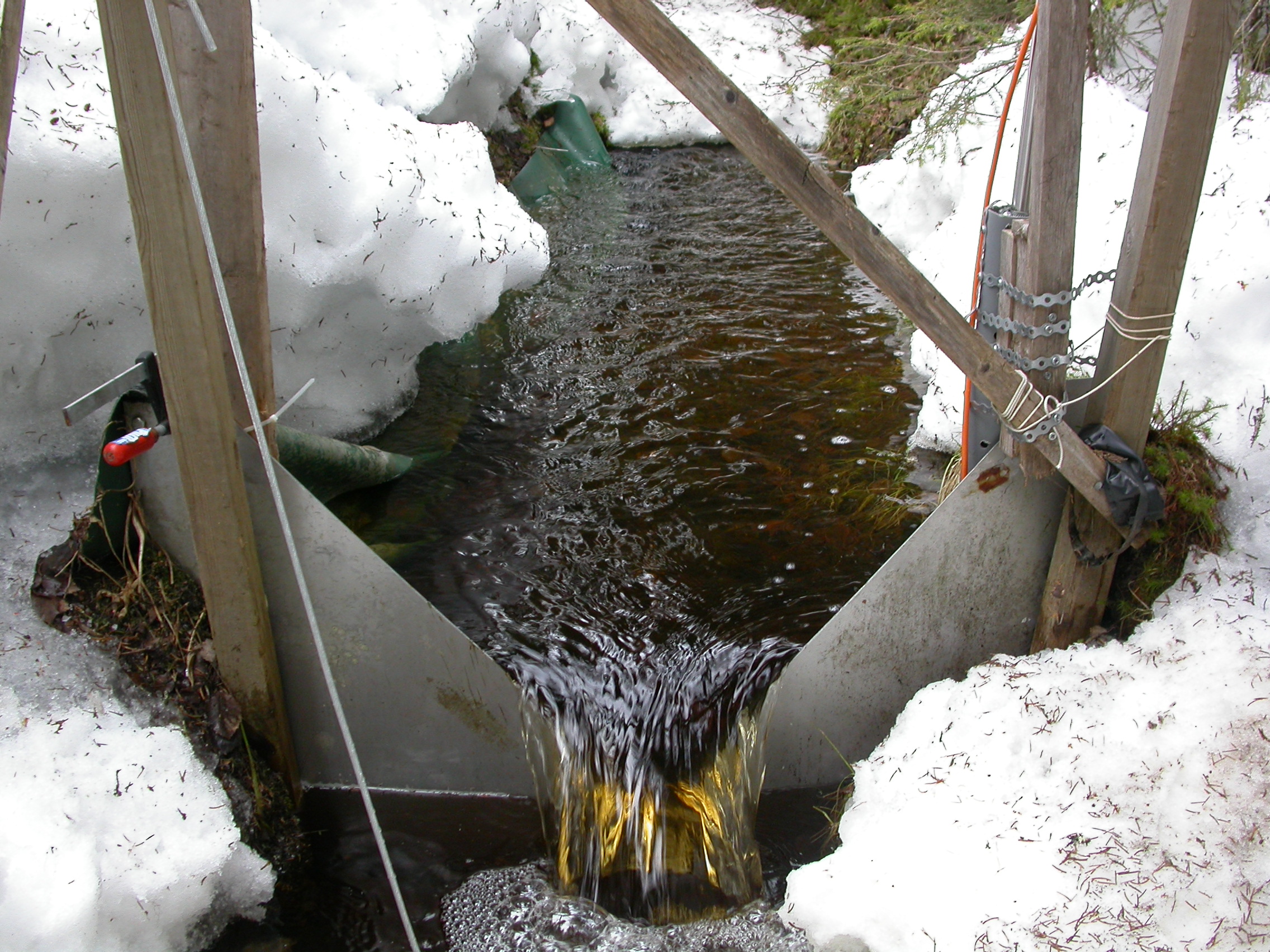
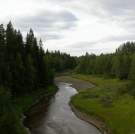
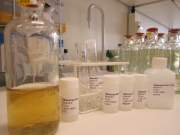
Since 1979 precipitation as both rain and snow have been collected daily at the Svartberget experimental forests field station (located in the central part of the Krycklan catchment). Precipitation chemistry has since 1983 been bulked monthly and analyzed for standard chemistry and hydrological isotopes.
During snowmelt every year, melting snow is collected. The amount of melted snow into water is weighted and the water is used for chemical analyses to give information about what enters the stream as a consequence of snowmelt and in the longer term we can disentangle what compounds that originate as additions from the soil and ground water.
The catchment (50ha) with many names (Svartberget, Nyänget, SVW, site 7) is where it all began in 1979. It is also the heart of much of the current research on the contrasting hydrological and biogeochemical behavior of forested and mire catchments. The Svartberget catchment also hosts the first soil experimental and monitoring sites that begun in 1997, including the S-transect and the Russian wells.
Recognition of the need to work at the landscape scale when addressing the influence of climate on aquatic ecology led to expansion of the 50 ha Svartberget catchment to the 6800 ha Krycklan catchment. This has led to a broadening of both the fundamental research questions and the management issues that are being addressed.
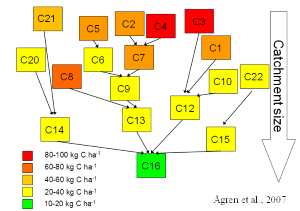 |
Annual export of DOC from the different sub-catchments in Krycklan. Note that the export of DIC can be as large, or even larger. Here you can also observe how the streams are connected. |
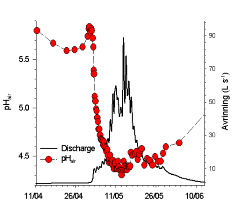
Decline of pH during the spring flood at C7. This decline is mainly driven by natural processes caused by increases in the concentration of DOC (dissolved organic carbon).
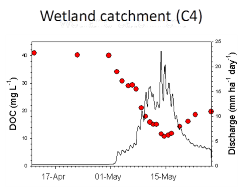
The contrasting behavior of DOC between the forested catchments and wetland dominated catchments.
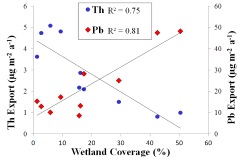
The contrasting behavior of different elements in the landscape depends on 1) Its affinity to organic matter and 2) the primary source of the element. For the examples above, thorium (Th) and lead (Pb) the affinity to organic matter are similar but whereas thorium is a weathering product, lead originates mainly from deposition.
The 19 streams included in the regular program are sampled approximately 25 to 30 times a year, twice a week during spring flood, once a month during winter conditions and every second week, during the rest of the year. Standard analysis program includes;
During some years several additional samplings has been included to this regular program; Hg, REE, fluorescence, suspended material, isotopes, LMW DOM and bioassays.
During at least 5 occasions a larger number of streams (50-90) have been sampled, these streams are spread in the whole Krycklan Catchment. Some surveys have only focused on discharge while other has also included water chemistry or ecology. The chemistry avaliable from the survey includes TOC, cations, anions, pH and absorbance spectra.
Jansson, M., et al. (2012). Bioavailable phosphorus in humic headwater streams in boreal Sweden. Limnology and Oceanography, 57, 1161–1170.
Bergknut, M., et al (2011). Atmospheric deposition and retention of dioxins and PCBs in a pristine boreal catchment. Environmental Pollution, 159, 1592-1598.
Lidman, F., et al. (2011). Selenium dynamics in boreal streams: The role of wetlands and changing groundwater tables. Environmental Science and Technology, 45, 2677-2683.
Köhler, S.J., et al. K. (2008). Intra- and interannual variability of total organic carbon in two contrasting boreal landscape elements. J. Geophysical Research-Biogeosci. 113, G03012.
Bishop, K., et al. (2008). Aqua Incognita: The Unknown Headwaters, Hydrological Processes, 22, 1239-1242.
Laudon, H. et al. (2004). Seasonal dependency in DOC export from seven boreal catchments in northern Sweden. Aquatic Sciences. 66, 223-230.
Bishop, K., et al. (2000). Separating the natural and anthropogenic components of spring flood pH decline: A method for areas that are not chronically acidified. Water Resources Research, 31, 1873-1889.
Laudon, H., et al. (2011). Patterns and Dynamics of Dissolved Organic Carbon (DOC) in Boreal Streams: The Role of Processes, Connectivity, and Scaling Ecosystems, 14, 880-893
Bergknut, M. et al. (2010) Modelling the fate of hydrophobic organic contaminants in a boreal forest catchment: A cross disciplinary approach to assessing diffuse pollution to surface waters. Environmental Pollution, 158, 2964-2969.
Wallin, M. et al. (2010) Temporal and spatial variability of dissolved inorganic carbon in a boreal stream network – concentrations and downstream fluxes, J. Geophys. Res.-Biogeo. 2009JG001100.
Björkvald, L. et al. (2008). Hydrogeochemistry of Fe and Mn in small boreal catchments: The role of seasonality, landscape type and scale. Geochem. Cosmoch. Acta 72, 2789-2804.
Berggren, M., Laudon, H. and Jansson, M. (2007). Growth and respiration of freshwater bacteria on organic carbon from different terrestrial sources, Global Biogeochemical Cycles, 21 (4): doi:10.1029/2006GB002844.
Ågren, A., et al. (2007). Importance of seasonality and small streams for the landscape regulation of DOC export. J. Geophys. Res.-Biogeo, 112, G03003.
Buffam, I., et al. (2007). Landscape-scale variability of acidity and dissolved organic carbon during spring flood in a boreal stream network. J. Geophys. Res.-Biogeo. 112, G01022
Svartberget hosts a third of the Swedish ICOS sites, which includes one of three atmospheric towers and two of the six ecosystem sites.
|
|
|
The 150 m high ICOS tower in Krycklan (left) integrates the carbon signal for most of northern Sweden. However, sensors mounted at lower elevations also measure carbon, energy and water exchange rates between the atmosphere and the soil/forest canopy more locally. The Swedish ICOS is funded 2010 – 2014 by the VR Infrastructure committee with the stated ambition of long-term funding for 20 - 30 years.
Visit ICOS homepage for more information
The riparian zone has a disproportional large impact on the stream biogeochemistry. Partly this is because it is the large last environment the soil water meets before becoming surface water. But this large influence also has to do with the fact that the riparian soil in the boreal region is highly organic rich, and therefore very different compared to most other soils in the catchment.
The riparian zone experiment in Krycklan is called the S-transect and was installed 1997. Along with the Soil frost manipulation and several of the ground water tubes the S-transect is located in the forested catchment, Västrabcäken (C2). The three plots are located in the riparian zone 4 m from the stream (S04), 12 m from the stream (S12) and in the upslope mineral soil 22 m from the stream (S22). The hydrology is focused in the upper horizons due to the hydrological conductivity which increases exponentially towards the soil surface.
Along the gradient at 4, 12 and 22 meters distance from the stream, ceramic lysimeter cups are installed in the ground collecting soil water at different depths. In addition to the lysimeters probes and thermisors are used to measure soil water content and soil temperatures at the same depths. Water from this experiment is sampled monthly and analysed for TOC, TN, pH, cations and anions.
Information from the S-transect can be used to understand and interpret the transportation and mobilization of chemical compounds through the ground to the streams via the riparian zone.
The transect consists of three profiles of ceramic suction lysimeters at 5-7 depths in three plots. The installations are made so that samples can be collected all year by using a heating cable where the water passes through the frozen soil.
Contrasting patterns of strontium (which has low affinity to DOC) and aluminium which has a very high affinity to DOC. Most other elements in the periodic table behave similarly depending on their DOC affinity.
Key references
Winterdahl, M., et al. (2011). Riparian soil temperature modifies relationship between flow and organic carbon concentration in a boreal stream. Water Resour. Res. (47), W08532.
Seibert, J., et al. (2009), Linking soil- and stream-water chemistry based on a Riparian Flow-Concentration Integration Model, Hydrology and Earth Science Systems, 13, 2287-2297
Öquist, M.G., et al. (2009). Dissolved Inorganic Carbon Export Across the Soil/Stream Interface and Its Fate in a Boreal Headwater Stream, Environmental Science and Technology, 43, 7364-7369.
Petrone, K., et al. (2007). Hydrologic and biotic control of nitrogen export during snowmelt: a combined conservative and reactive tracer approach. Water Resour Res, 43, W06420.
Klaminder, J., et al. (2006). Flux rates of atmospheric lead pollution within soils from a small catchment in northern Sweden and their implication for future stream water quality, Environmental Science and Technology, 40, 4639-4645.
Bishop, H., et al. (2004). Resolving the Double Paradox of rapidly mobilized old water with highly variable responses in runoff chemistry. Hydrological Processes. 18, 185-189.
Laudon, H., et al. (2004). Hydrological flow paths during the spring flood: Congruence between hydrometric measurements and oxygen-18 in snow melt, soil water, and runoff, Water Resources Research. 40 (3), W03102.
The Kallkäls mire and the “Russians wells” at the end of the board walk. The “Russian wells” are a set of piezometers allowing sampling at different depths (25-450cm) and below the mire. The mire becomes stream C4.
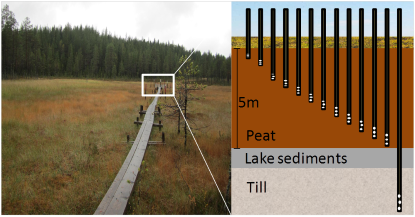
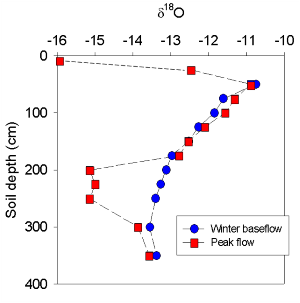 |
Flow pathways through the mire during spring snow melt using the stable isotope oxygen-18 (d18O) as tracers. Note the two dominating path-ways, 1. As overland flow over the frozen soil and 2. Through the mire at 2 to 2.5 meters depth at some preferential pathway. |
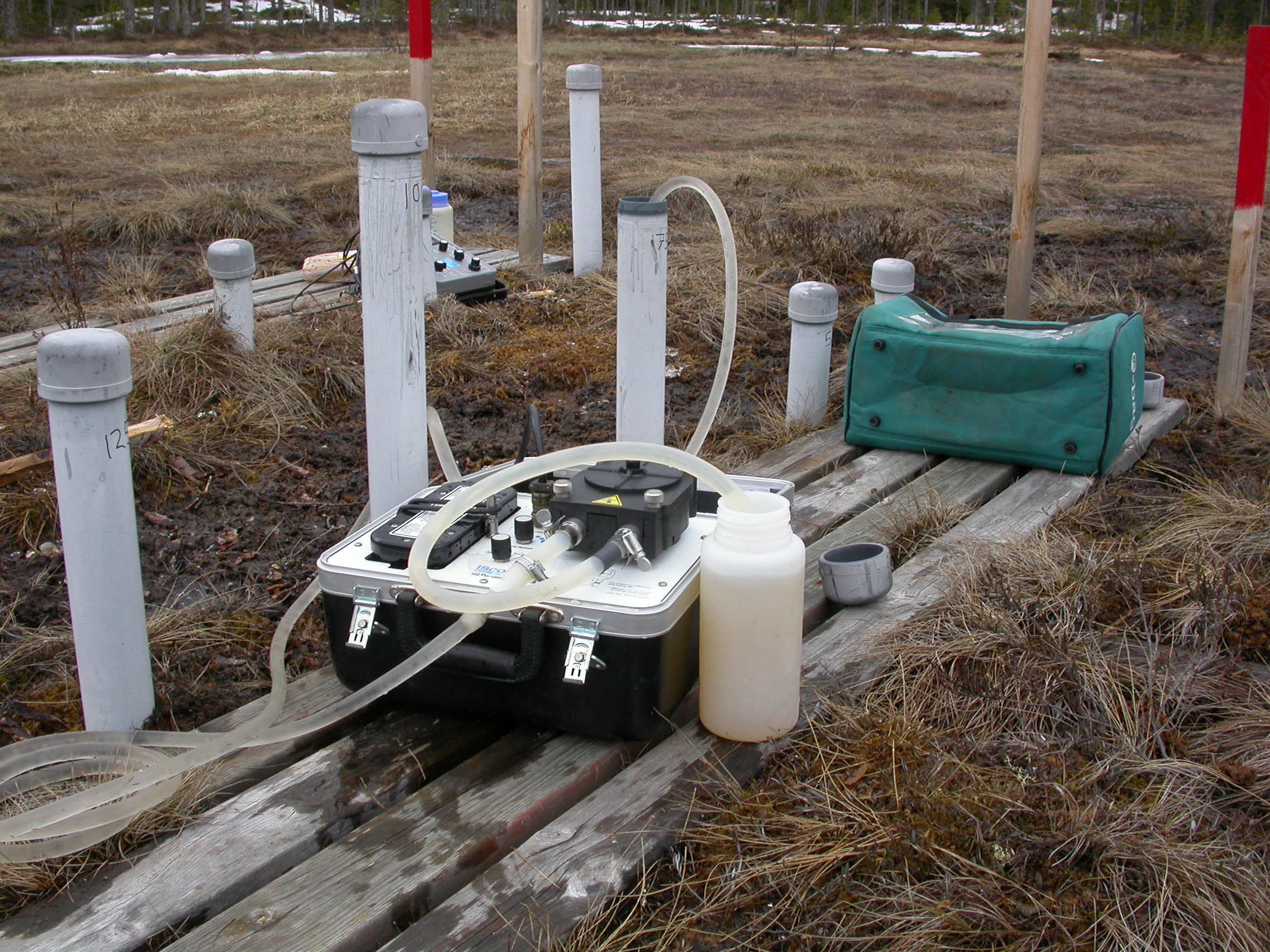
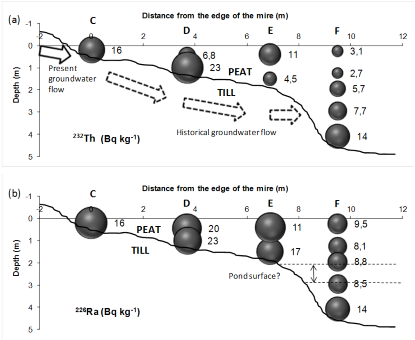
Profile of chemical analyses following the pathway of water as it flows from the mineral soil into the mire. Here we show the activity (concentration) of thorium (above) which is an element with a high affinity to DOC and radium (below) with low affinity to DOC (From Lidman et al. 2012).
Key references
Lidman, F., et al. (2012). Distribution and transport of radionuclides in a boreal mire - assessing past, present and future accumulation of uranium, thorium and radium. Journal of Environmental Radioactivity, DOI: 10.1016/j.jenvrad.2012.06.010.
Ågren, A., et al. (2012). Soil frost enhances stream dissolved organic carbon concentrations during episodic spring snow melt from boreal mires. Global Change Biology, doi: 10.1111/j.1365-2486.2012.02666.x
Bergknut, M., et al. (2010) Dioxins, PCBs, and HCB in soil and peat profiles from a pristine boreal catchment, Environmental Pollution, 158, 2518-2525.
Grabs, T., et al. (2009). Modeling spatial patterns of saturated areas: A comparison of the topographic wetness index and a dynamic distributed model. Journal of Hydrology, 373, 15-23.
Yurova, A., et al. (2008).Modeling the DOC output from a boreal mire using the convection dispersion equation: The importance of representing sorption. Water Resources Research, 44, W07411, doi:10.1029/2007WR006523.
Laudon, H., et al. (2007). The role of catchment scale and landscape characteristics for runoff generation of boreal streams. Journal of Hydrology, 344, 198-209.
This unique experiment is located in the small forested catchment of Västrabäcken. The soil frost experiment begun in 2002 which makes it the longest ongoing experiment of its kind anywhere in the world. Winter conditions in the soil are strongly dependent on the timing and amount of snow. Little snow gives very cold soils, whereas early and large amounts of snow will result in “warm” soils.
The design comprise of nine plots located in the forest at four meters distance from the stream. All nine plots are replicates of three simulations, control, roofed and insolated.
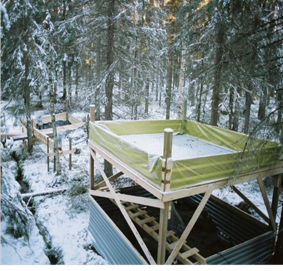 |
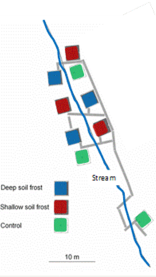 |
Roofed plots collects the snow, leaving the ground bare simulating deep soil frost. For the insultation simulation styrofoam bags are added every autumn to prevent formation of soil frost. In each of these plots soil water lysimeters are installed for sampling at 10, 25, 40, 60 and 80 cm depths along with probes and thermistors. Soil water from these plots are analysed for TOC, TN, absorbance spectra, cations and anions.
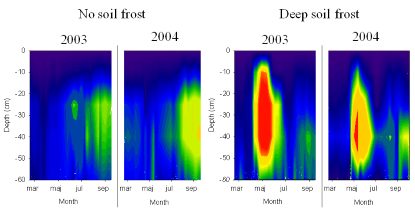
CO2 concentrations at different depth in the soil over two years in soil without soil frost (left) and with extensive soil frost (right ). From Öquist and Laudon, 2008.
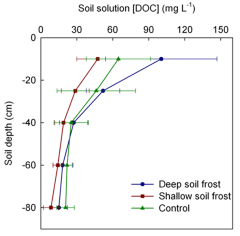
Colder soils and deeper soil frost gives higher DOC concentrations in the upper soil layers. Colder soils also gives rise to higher DOC concentration in the streams during the spring flood.
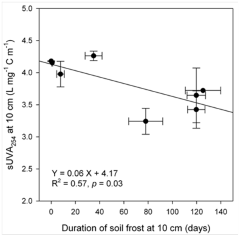
The DOC quality is also affected negatively by the length of winter. Here it is measured as SUVA (from Haei et al. 2011).
Key references
Kreyling, J., et al. (2012). Absence of snow-cover reduces understory plant cover and alters plant community composition in boreal forests. Oecologia, 168, 577-587.
Haei M., et al. (2012). The influence of soil frost on the quality of dissolved organic carbon in a boreal forest soil - combining field and laboratory experiments, Biogeochemistry, DOI: 10.1007/s10533-010-9534-2.
Haei, M., et al. (2011).Effects of soil frost on growth, composition and respiration of the soil microbial decomposer community. Soil Biology & Biochemistry 43, 2069-2077.
Ågren, A., et al. (2010). Regulation of stream water dissolved organic carbon (DOC) concentrations during snowmelt; the role of discharge, winter climate and memory effects. Biogeosciences, 7, 2901-2913.
Haei, M., et al (2010). Cold winter soils enhance dissolved organic carbon concentrations in soil and stream water. Geophysical Research Letters, 37, L08501, doi: 10.1029/2010GL042821.
Öquist, M.G. and Laudon, H. (2008). Winter soil-frost conditions in boreal forests control growing season soil CO2 concentration and its atmospheric exchange, Global Change Biology, 14, 1-9 doi: 10.1111/j.1365-2486.2008.01669.x
At 20 locations across the Krycklan catchment there are groundwater tubes installed. The wells extend from a depth of 0.5 to 150 meters.
The first wells were installed by the Swedish Geological Survey (SGU) in the 1980s and have been monitored since, In 2012 the majority of the wells wew installed.
Analysis program running for ground water are O-18, DOC, TN, DIN, absorbance spectra, cations, anions and archive.
The installations are made to span the entire catchment to investigate regional groundwater as well as allow more local studies of water pathways.
Stable isotope oxygen 18 (δ18O) in groundwater wells and streams sampled during base flow. Dashed lines indicates the δ18O ratio for shallow groundwater (<0.9 m depth) and deep groundwater (>1 m depth). Arrow indicates the general downstream trend.
Base cation concentrations of the same streams in relation to soil water from 0.5 m depth and deep groundwater (>1 m depth) (Fig. from Klaminder et al. 2011).
Key references
Klaminder, J., et al. (2011). Carbon mineralization and pyrite oxidation in groundwater: importance for silicate weathering in boreal forest soils and stream base-flow chemistry, Applied Geochemistry, 26, 319-324.
Klaminder, J., et al. (2011). Silicate mineral weathering rate estimates: Are they precise enough to be useful when predicting the recovery of nutrient pools after harvesting? Forest Ecology and Management, 261, 1–9.
Björkvald, L. et al. (2009). Landscape variations in stream water SO4 and d34S in a boreal stream network. Geochimica et Cosmochimica Acta, 73, 4648-4660.
Mörth, C.M. et al. (2008). Sources of stream water sulfate during the spring snowmelt in boreal streams: evidence from stable δ34S isotope measurements. Journal of Geophysical Research-Biogeosciences, doi:10.1029/2007JG000457.
Laudon, H., et al. (2007). The role of catchment scale and landscape characteristics for runoff generation of boreal streams. Journal of Hydrology, 344, 198-209.
Lake Stortjärn is one of the most expansive research sites in Krycklan in later years both in terms of new projects and in infrastructure development.
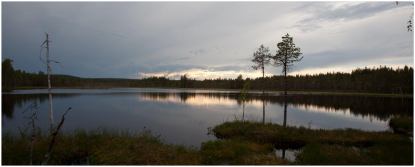
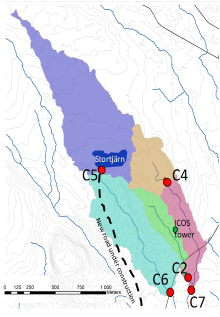
Examples of infrastructure at Lake Stortjärn:
Given the critical role of the riparian ecotone in defining the connection between soils and water, a riparian observatory (RO) was established in 2007. RO consists of 15 sites located all over the catchment decided upon varying wetness and soil types in order to provide more spatially distributed data on soil/stream water interaction. RO has been an important component in the development of the RIM-model.
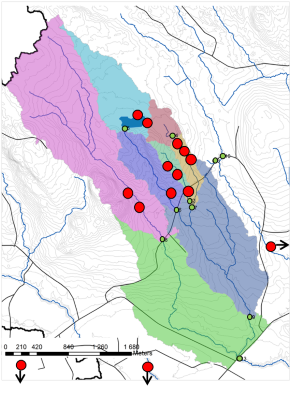
The riparian observatory is distributed at 15 different sites in Krycklan and is designed to investigate the soil-stream interaction in terms of hydrology and biogeochemistry. It is similar to the S-transect in design at 5 locations with a transect from uphill to riparian zone.
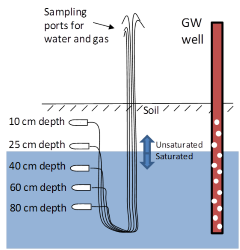
Each of the 15 RO sites has installations for soil water and soil gas sampling and ground-water (GW) monitoring. Five of the sites have installations both in the riparian zone and uphill, 20-30 m away from the RO site to study the chemical evolution of water along the flow pathway.
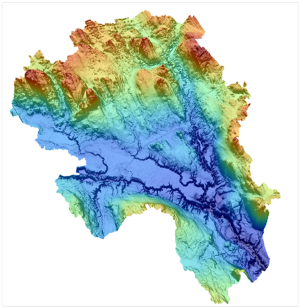
Lidar based topography in Krycklan. Based on the high resolution lidar 10, 5 and 0.5 m digital elevation models (DEM) are available for the entire 68 km2 catchcment.
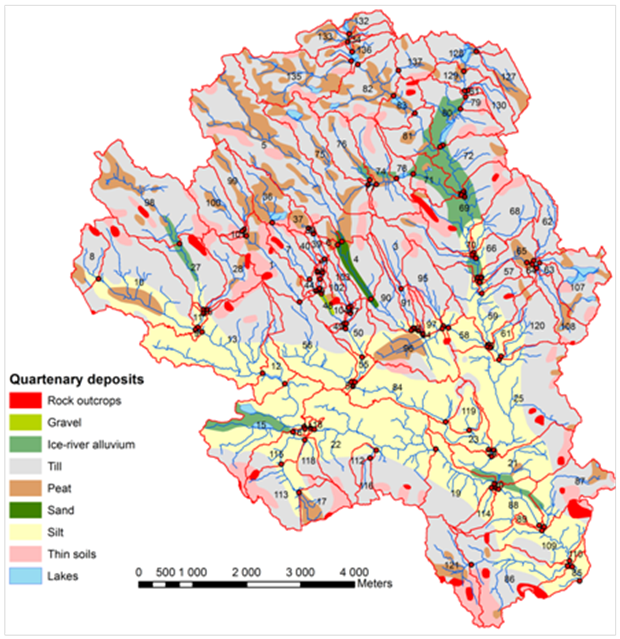
Quarternary deposits map with the 100 ”Survey locations” superimposed. The survey catchments are sampled less often compared to the regular sites.
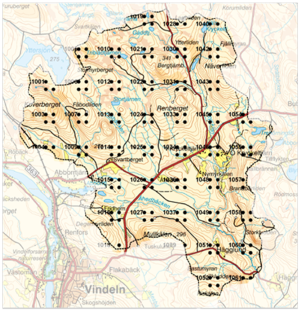
Vegetation survey (marked with black circles) carried out using the National Forest Inventory protocol.
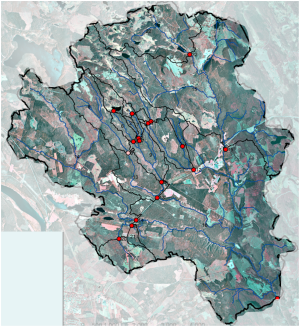
IR-ortophoto of the Krycklan catchment with the regular sites in red.
Key references
Lyon, S.W., et al. (2012). Specific discharge variability in a boreal landscape, Water Resources Research. 48, W08506, doi:10.1029/2011WR011073.
Nathanson, M., et al. (2012). Modeling rating curves using remotely sensed LiDAR data. Hydrological Processes, DOI: 10.1002/hyp.9225.
Lyon, S.W., et al. (2011). Variability of groundwater levels and total organic carbon (TOC) in the riparian zone of a boreal catchment, Journal of Geophysical Research-Biogeoscience, 116, G01020, doi:10.1029/2010JG001452.
Ågren, A., et al. (2010) Sensitivity of pH in a boreal stream network to a potential decrease in base cations caused by forest harvest. Canadian Journal of Fisheries and Aquatic Sciences 67, 1116-1125.
Cory, N., et al (2009). Particulate aluminium in boreal streams: Towards a better understanding of its sources and influence on dissolved aluminium speciation. Applied Geochemistry, 24, 1677-1685.
Buffam, et al. (2008). Spatial heterogeneity of the spring flood acid pulse in a boreal stream network, The Science of Total Environment, 407, 708-722.
Grabs, T., et al. (2009). Modeling spatial patterns of saturated areas: A comparison of the topographic wetness index and a dynamic distributed model. Journal of Hydrology, 373, 15-23.
A number of more stream ecology oriented studies have been conducted related to fish and invertebrates in the streams and terrestrial ecology along the riparian zone.
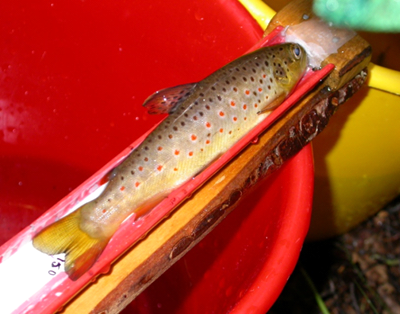
In 2006 a systematic survey of fish distribution using electrofishing was conducted at 50 different locations in the Krycklan stream network. Fish survival experiments and invertebrate population studies have also been carried out in 15 of the 19 monitored streams. Water column microbial community productivity and respiration have been monitored extensively at numerous stream and lake sites throughout KCS.
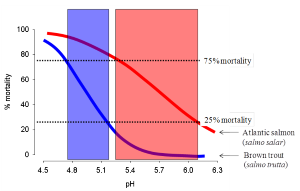
Acidity thresholds for young (1+) fish measured in the Krycklan. These results are now a basis for the new SEPA guidelines for liming.
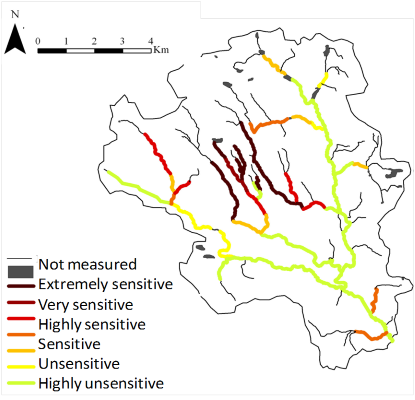
Sensitivity of the Krycklan streams for changes in pH and how that acid sensitive species can be affected (From Ågren et al. 2010).
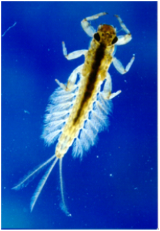
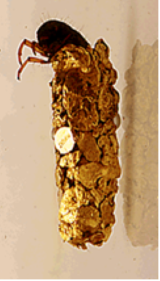
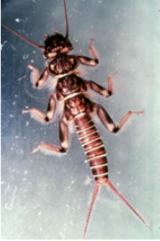
Key references
Laudon, H. and Buffam, I. (2008). Impact of changing DOC concentrations on the potential distribution of acid sensitive biota in a boreal stream network, Hydrology and Earth System Science, 12, 425–435.
Serrano, I, et al. (2008). Thresholds for survival of brown trout (Salmo trutta) embryos and juveniles during the spring flood acid pulse in DOC-rich streams. Transactions of the American Fisheries Society, 137, 1363-1377.
Petrin, Z. (2007) Landscape-controlled chemistry variation affects communities and ecosystem function in head-water streams. Canadian Journal of Fisheries and Aquatic Sciences, 64, 1563-1572
Petrin, Z., et al. (2007). Does freshwater macroinvertebrate diversity along a pH-gradient reflect adaptation to low pH? Freshwater Biology, 52, 2172-2183.
Jansson, R., et al. (2007). The importance of groundwater discharge for plant species richness in riparian zones. Ecology, 88, 131–139.
Dangles, O., et al. (2004). Naturally acid freshwater ecosystems are diverse and functional: evidence from boreal streams. Oikos. 104, 149-155.
This unique setup is located in the small forested catchmnet of Västrabäcken. The design comprise of nine plots located in the forest at four meters distance from the stream. All nine plots are replicates of three simulations, control, roofed and insolated.
Roofed plots collects the snow, leaving the ground bare simulating deep soil frost. For the insultation styrofoam bags are added every autumn to prevent formation of soil frost. In each of these plots soil water lysimeters are installed for sampling at 10, 25, 40, 60 and 80 cm depths along with probes and thermistors. Soil water from these plots are analysed for TOC, TN, absorbance spectra, cations and anions.
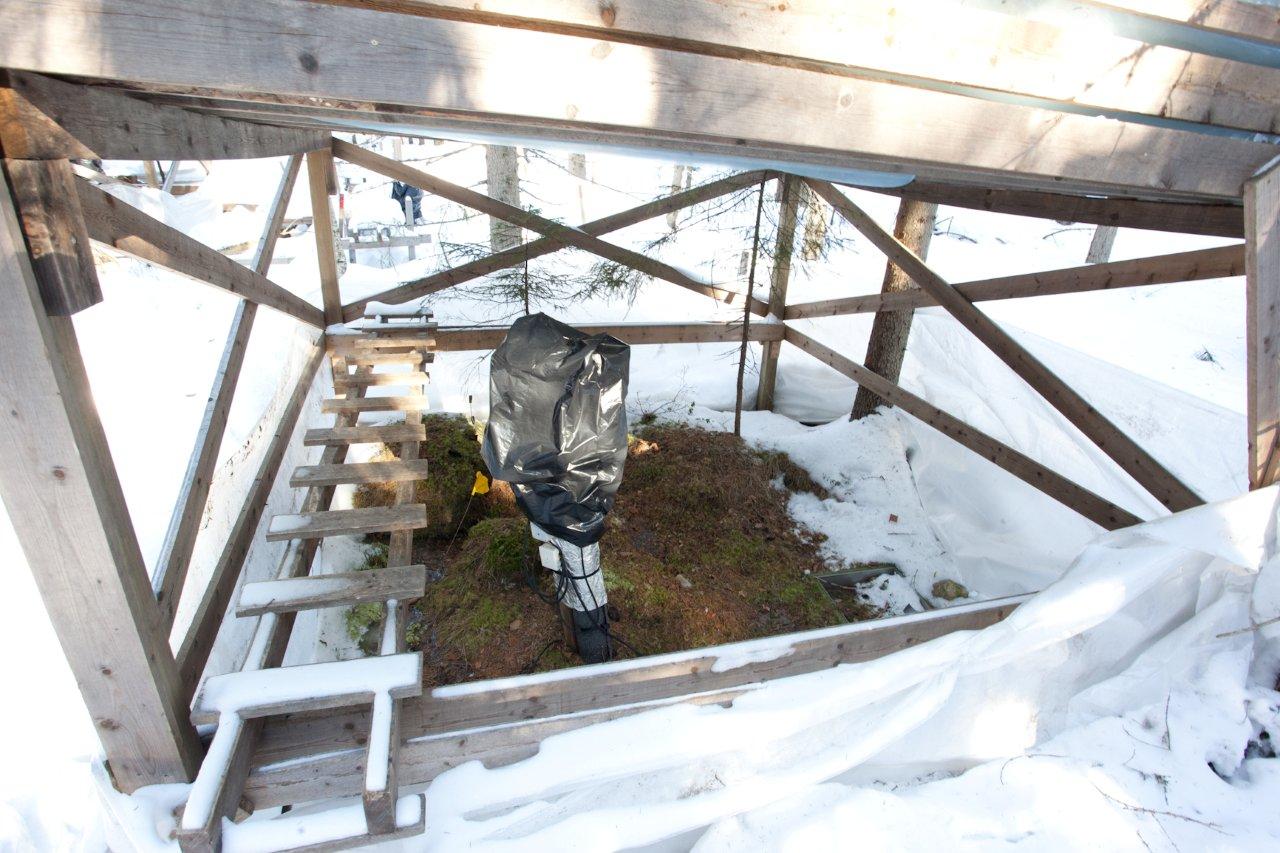
The S-transect refers to a topographic gradient aligned to follow the lateral flow paths of the groundwater towards one of the stream included in the Nyänget catchment. Along the gradient at 4, 12 and 22 meters distance from the stream, ceramic lysimeter cups are installed in the ground collecting soil water at different depths. In addition to the lysimeters probes and thermisors are used to measure soil water content and soil temperatures at the same depths. Water fom this experimnet is analysed for TOC, TN, pH, cations and anions.
Information from the S-transect can be used to understand and interpret the transportation and mobilization of chemical compounds trough the ground to the streams via the riparian zone.
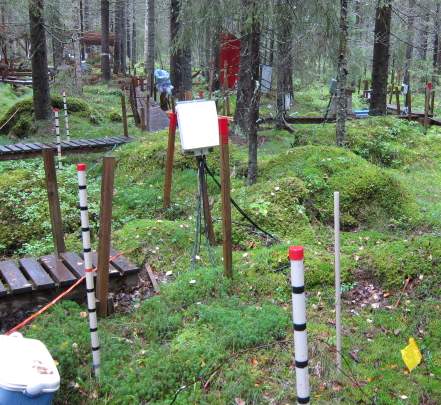
At several locations in the Krycklan catchment there are ground water tubes. At the mire upstream site 4 there are 14 tubes at different depths in the mire. The tubes reflects the movements and transportation of water at different depths in the mire. Five deeper ground water tubes were initiated in 1989 by the Sweish Geological Survey. KCS continous these measuremetns today. This year additionally nine tubes were installed at regular stream sites in Krycklan.
Analyses running for ground water are O-18, TOC, TN, DIN, absorbance spectra, cations, anions and archive.

Given the critical role of the riparian ecotone in defining the connection between soils and water, a riparian observatory (RO) was established in 2007. RO consists of 13 sites located all over the catchment decided upon varying wetness and soil types in order to provide more spatially distributed data on soil/stream water interaction.
RO has been an important component in the development of the RIM-model.
